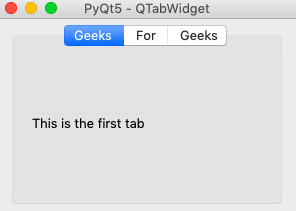PyQt5 – QTabWidget
在本文中,您将学习如何在 PyQt5 应用程序中添加和使用选项卡窗口。每个选项卡都有不同的布局,并显示所选选项卡下的页面,同时隐藏其他选项卡。要选择一个选项卡,您需要从该QTabWidget提供的选项卡栏中单击所需的选项卡。
下面的文章描述了创建具有三个选项卡且每个选项卡具有不同布局的示例应用程序的过程。
例子:
import sys
from PyQt5.QtWidgets import QMainWindow, QApplication, QPushButton, QWidget, QAction, QTabWidget, QVBoxLayout, QLabel
# Creating the main window
class App(QMainWindow):
def __init__(self):
super().__init__()
self.title = 'PyQt5 - QTabWidget'
self.left = 0
self.top = 0
self.width = 300
self.height = 200
self.setWindowTitle(self.title)
self.setGeometry(self.left, self.top, self.width, self.height)
self.tab_widget = MyTabWidget(self)
self.setCentralWidget(self.tab_widget)
self.show()
# Creating tab widgets
class MyTabWidget(QWidget):
def __init__(self, parent):
super(QWidget, self).__init__(parent)
self.layout = QVBoxLayout(self)
# Initialize tab screen
self.tabs = QTabWidget()
self.tab1 = QWidget()
self.tab2 = QWidget()
self.tab3 = QWidget()
self.tabs.resize(300, 200)
# Add tabs
self.tabs.addTab(self.tab1, "Geeks")
self.tabs.addTab(self.tab2, "For")
self.tabs.addTab(self.tab3, "Geeks")
# Create first tab
self.tab1.layout = QVBoxLayout(self)
self.l = QLabel()
self.l.setText("This is the first tab")
self.tab1.layout.addWidget(self.l)
self.tab1.setLayout(self.tab1.layout)
# Add tabs to widget
self.layout.addWidget(self.tabs)
self.setLayout(self.layout)
if __name__ == '__main__':
app = QApplication(sys.argv)
ex = App()
sys.exit(app.exec_())
输出: 
如果要在任何选项卡上添加图标。你只需要更换
self.tabs.addTab(self.tab1, "Geeks")和
self.tabs.addTab(self.tab1, QIcon("Location of the icon"), ('Geeks')) 并从PyQt5.QtWidgets导入QIcon库。